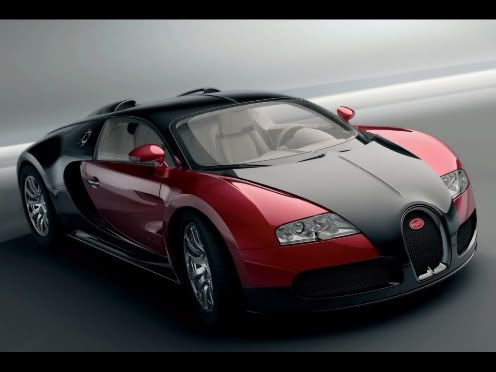
-$1,700,000-
This is by far the most expensive street legal car available on the market today. It is the fastest accelerating car reaching 0-60 in 2.6 seconds. It claims to be the fastest car with a top speed of 253 mph+. However, the title for the fastest car goes to the SSC Ultimate Aero which exceed 253 mph pushing this car to 2nd place for the fastest car.
History
This section does not cite any references or sources. Please help improve this article by adding citations to reliable sources. Unsourced material may be challenged and removed. (January 2009)
Development of this vehicle began with the 1999 EB 16/4 "Veyron" concept car, which itself had a chassis based on that of the Bugatti 18/3 Chiron concept car. It was similar in design and appearance to the final Veyron production car. One major difference was the EB 18/4's use of a W18 engine with three banks of six cylinders. The Veyron's chief designer was Hartmut Warkuss, and the exterior was designed by Jozef Kabaň of Volkswagen Group, rather than Giorgetto Giugiaro of ItalDesign, who had handled the three prior Bugatti concepts.
The then – Volkswagen Group chairman Ferdinand Piëch announced the Veyron at the 2000 Geneva Motor Show. It was promised to be the fastest, most powerful and most expensive car in history. Instead of the W18, it would use a VR6/WR8-style W16 engine. First seen in the 1999 Bentley Hunaudières concept car, the W16 would have four turbochargers, and produce a quoted 736 kilowatts (1,001 PS; 987 bhp) (see engine section for details on the power output). Top speed was promised at 407 kilometres per hour (252.9 mph), and the price was announced at €1 million.
Development continued throughout 2001, and the EB 16/4 Veyron was promoted to "advanced concept" status. In late 2001, Bugatti announced that the car, officially called the "Bugatti Veyron 16.4", would go into production in 2003. Taking great pride in the making of the Veyron, the production plant (where cars are also ordered) is affectionately called the "Atelier" which means an artists workroom.
A silver and black pre-production Veyron on display at the 2004 Paris Motor Show
Piëch retired that year as chairman of the Volkswagen Group, and was replaced by Bernd Pischetsrieder. The new chairman promptly sent the Veyron back to the drawing board for major revisions. Neumann was replaced as Bugatti president by Thomas Bscher in December 2003, and substantial modifications were made to the Veyron under the guidance of a former Volkswagen Group engineer, Bugatti Engineering chief Wolfgang Schreiber.
The Veyron costs €1,100,000 (net price without taxes);prices vary by exchange rates, and local taxes (like value added taxes). Prices for the UK or the US are over £880,000, or around $1,400,000. It was noted in an April issue of "Live" magazine (weekly mens magazine with the Sunday Times) that customers are free to order additional extras which can push the price up by the cost of a Rolls Royce Phantom. The car is often compared to the Concorde as a feat of technology.
Special Editions
- Pur Sang
- Fbg par Hermès
- Sang Noir
- Grand Sport
- Bleu Centenaire
- Linea Vincerò by Mansory
- Sang Bleu
Specifications and Performance
- The Veyron's quad-turbocharged W16 engine
The Veyron features an 8.0 litre W16 engine — 16 cylinders in two banks of eight cylinders, or the equivalent of two narrow-angle V8 engines mated in a "W" configuration. Each cylinder has four valves for a total of 64, but the narrow staggered 8 configuration allows two overhead camshafts to drive two banks of cylinders so only four camshafts are needed. The engine is fed by four turbochargers and displaces 7,993 cubic centimetres (487.8 cu in), with a square 86 mm by 86 mm (3.4 in × 3.4 in) bore and stroke.
The transmission consists of a dual-clutch Direct-Shift Gearbox computer-controlled manual gearbox with seven gear ratios, with magnesium paddles behind the steering wheel and a shift time of less than 150 milliseconds. This is designed and manufactured by Ricardo of England (and not Borg-Warner who designed the six-speed DSG used in the mainstream marques of the Volkswagen Group). The Veyron can be driven as a full automatic transmission. It also features full-time permanent four-wheel drive, utilising the Haldex Traction system. It uses special Michelin PAX run-flat tyres, designed specifically for the Veyron to accommodate its top speed, which reportedly cost $25,000 US per set.[14] Kerb weight is 2,034.8 kilograms (4,486 lb). This gives the car a power to weight ratio, according to Volkswagen Group's 736 kilowatts (1,001 PS; 987 bhp) figures, of 446.3 bhp per ton.
The car's wheelbase is 2,710 mm (106.7 in). Overall length is 4,462 mm (175.7 in), width 1,998 mm (78.7 in) and height 1,204 mm (47.4 in).
The Veyron's hydraulic rear spoiler in the extended position
It has a drag coefficient of 0.41 (normal condition) and 0.36 (after lowering to the ground), and a frontal area of 2.07 square metres (22.3 sq ft). This gives it a CdA ft² value of 8.02.
Engine Output
According to Volkswagen Group, the DIN rated motive power output, approved by TÜV Süddeutschland, of the final production Veyron engine produces 736 kilowatts (1,001 PS; 987 bhp), and generates 1,250 newton metres (922 ft·lbf) of torque. The figure has been confirmed by Bugatti officials to actually be conservative, with the real total being 753 kilowatts (1,024 PS; 1,010 bhp) or more.
Top Speed
The top speed was verified once again by James May on Top Gear for the November 2006 issue, again at Volkswagen Group's private Ehra-Lessien test track, where the final-production car hit 408 kilometres per hour (253.5 mph), which equated to nearly one-third of the speed of sound at sea level. As the Bugatti Veyron approached the top speed during the test, May said that "the tyres will only last for about fifteen minutes, but it's okay because the fuel runs out in twelve minutes". He also gave an indication of the power requirements, at a constant 155 mph (249 km/h), the Veyron is using approximately 270 to 280 horsepower (200 to 210 kW), but to get to its rated 408 km/h (253.5 mph) top speed required far more from the engine. Once back in the Top Gear studio, James was asked by co-presenter Jeremy Clarkson what the Veyron felt like to drive at 407 km/h (252.9 mph), James replied that it was "totally undramatic", and very stable at speed.
2. LAMBORGHINI REVENTON
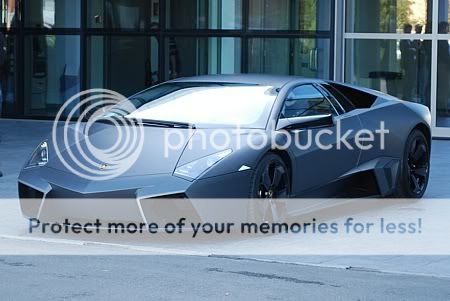
$1,600,000
The most powerful and the most expensive Lamborghini ever built is the second on the list. It takes 3.3 seconds to reach 60 mph and it has a top speed of 211 mph. Its rarity (limited to 20) and slick design are the reasons why it is so expensive and costly to own.
The Lamborghini Reventón is a mid engined car that debuted at the 2007 Frankfurt Auto Show. It ranks as the most powerful and expensive Lamborghini road car to date, costing one million euros (US$1.5 million, or £858,000). The official press release stated that only 20 vehicles would be released to the public, with one additional car (marked as 0/20) produced for the Lamborghini Museum. Although early rumours indicated the total number would actually be 100, each Reventón is clearly stamped with its number in the sequence of 20 between the driver's and passenger's seats.
Name
The Reventón is named after a fighting bull in keeping with Lamborghini tradition. The bull, raised by the don Heriberto Rodríguez family, was best known for killing famed bullfighter Félix Guzmán in 1943. Reventón means "explosion" or "burst" in Spanish, when used as a noun. In the vernacular, it is also used to define a very large party or a night on the town. It's commonly said "vámonos de reventón", which means "let's go party tonight." In automotive terms, it means "blowout, flat tire" when used as a noun. When it was used as the name of a bull, however, it was intended to be interpreted as an adjective, a quality or property of that bull in particular. In this last sense, Reventón means "he who seems to be about to burst".
Specifications
- Performance
The Reventón's engine was a slightly tuned version of the Murciélago LP640's 6.5 L V-12, rated at 640 hp (480 kW). According to the official release, the Reventón accelerates to 100 km/h (62 mph) in the same time as the Murciélago LP640 (3.4 seconds), and is capable of reaching a maximum speed of over 340 km/h (210 mph). Using the internal speedometer, the recorded top speed was displayed as 356 km/h (221 mph).
Reventón RoadsterCars UK reported the production of 9 Lamborghini Reventón Roadsters, with MSRP of €1,200,000. The car would use the engine from Murciélago LP 670-4 SuperVeloce. Autocar has since published a report in July 2009 saying that potential buyers have been shown the car - although a Lamborghini spokesman told the publication that reports of the car were "just speculation"
3. MCLAREN F1

$970,000
Specifications
Chief engineer Gordon Murray's design concept was a common one among designers of high-performance cars: low weight and high power. This was achieved through use of high-tech and expensive materials like carbon fibre, titanium, gold, magnesium and kevlar. The F1 was the first production car to use a carbon-fibre monocoque chassis.
The idea was first conceived when Murray was waiting for a flight home from the fateful Italian Grand Prix in 1988; Murray drew a sketch of a three seater sports car and proposed it to Ron Dennis, pitched as the idea of creating the ultimate road car, a concept that would be heavily influenced by the Formula One experience and technology of the company and thus reflect that skill and knowledge through the McLaren F1.
Engine
- History

Gordon Murray insisted that the engine for this car be naturally aspirated to increase reliability and driver control. Turbochargers and superchargers increase power but they increase complexity and can decrease reliability as well as introducing an additional aspect of latency and loss of feedback, the ability of the driver to maintain maximum control of the engine is thus decreased. Murray initially approached Honda for an NA powerplant with 550 bhp (410 kW; 560 PS), 600 mm (23.6 in) block length and a total weight of 250 kg (551 lb), it should be derived from the Formula One powerplant in the then-dominating McLaren/Honda cars.
| Manufacturer | McLaren Automotive |
|---|---|
| Production | 1992–1998 (106 produced) |
| Class | Sports car |
| Body style(s) | 2-door 3-seat coupé |
| Layout | RMR layout |
| Engine(s) | 60° 6.1 L V12 |
| Transmission(s) | 6-speed manual |
| Wheelbase | 2,718 mm (107.0 in) |
| Length | 4,287 mm (168.8 in) |
| Width | 1,820 mm (71.7 in) |
| Height | 1,140 mm (44.9 in) |
| Curb weight | 1,140 kg (2,513 lb) |
| Designer | Gordon Murray & Peter Stevens |
4. FERRARI ENZO

$670,000
The Enzo Ferrari, also known as Ferrari Enzo, is a 12 cylinder mid-engine berlinetta named after the company's founder, Enzo Ferrari. It is currently one of the most powerful naturally aspirated production cars.[citation needed] It was built in 2002 using Formula One technology, such as a carbon-fibre body, F1-style sequential shift transmission, and Carbon fibre-reinforced Silicon Carbide (C/SiC) ceramic composite disc brakes. Also used are technologies not allowed in F1 such as active aerodynamics and traction control. After a downforce of 775 kg (1,709 lb) is reached at 348.8 km/h (217 mph) the rear wing is actuated by computer to maintain that downforce.
The Enzo's V12 engine is the first of a new generation for Ferrari. It is based on the architecture of the V8 found in sister-company Maserati's Quattroporte, using the same basic architecture and 104 mm (4.1 in) bore spacing. This design will replace the former architectures seen in V12 and V8 engines used in most other contemporary Ferraris. The 2005 F430 is the second Ferrari to get a version of this new powerplant.
In 2004, Sports Car International named the Enzo Ferrari number three on their list of Top Sports Cars of the 2000s.
Motor Trend Classic named the Enzo as number four in their list of the ten "Greatest Ferraris of all time".
| |
Name
Though officially known as the Enzo Ferrari, the car is sometimes referred to colloquially as the "Ferrari Enzo", or simply as "Enzo" with no marque or other words attached. It can also be referred to by its original name the F60. Celebrating its first World Championship of the new Millennium, in Formula One, Ferrari built the Enzo to celebrate this achievement and the company named the car after its founder, Enzo Ferrari, who died in 1988.
Production
The Enzo was initially announced at the 2002 Paris Motor Show with a limited production run of 349 units and priced at US $643,330. The company sent invitations to existing customers, specifically, those who had previously bought the Ferrari F40 and Ferrari F50. All 349 cars were sold in this way before production began. Later, after numerous requests, Ferrari decided to build 50 more Enzos, bringing the total to 399. Before being unveiled at the Paris Motor show, the Enzo (that was used in the show) was flown from Italy to California to be filmed in Charlie's Angels: Full Throttle. It was driven on a beach by actress Demi Moore. After filming was complete, the Enzo was flown to France to be in the Motor Show. Enzos are listed as being built in 2003.
Ferrari built one more Enzo — the 400th car — and it was auctioned by Sotheby's Maranello Auction on June 28, 2005, to benefit survivors of the 2004 Tsunami for €950,000 (US$1,274,229), almost twice its list price. This sum was presented to Pope Benedict XVI, while former Ferrari Formula One driver Michael Schumacher gave the pope a steering wheel to commemorate the donation. This wheel included a plaque which read, "The Formula 1 World Champion's steering wheel to His Holiness Benedict XVI, Catholicism's driver."
The Enzo Ferrari typically trades above $1,000,000 (£500,000) at auction.
Three prototype "mules" were built, M1, M2, and M3. Each was bodied to look like a 348, even though the mules were built in 2000. The third mule was offered for auction alongside the 400th Enzo in June, 2005, bringing €195,500 (US$236,300).| Manufacturer | Ferrari |
|---|---|
| Parent company | Fiat Group |
| Production | 2002–2004 400 produced |
| Predecessor | Ferrari F50 |
| Successor | Ferrari FXX Millechili |
| Class | Sports car |
| Body style(s) | 2-seat Berlinetta |
| Layout | Rear mid-engine, rear-wheel drive |
| Engine(s) | 6.0 L V12 |
| Transmission(s) | 6 speed semi-automatic |
| Wheelbase | 2650 mm (104.3 in) |
| Length | 4702 mm (185.1 in) |
| Width | 2035 mm (80.1 in) |
| Height | 1147 mm (45.2 in) |
| Curb weight | 1365 kg (3009 lb) |
| Designer | Pininfarina |
5. PAGANI ZONDA C12 F
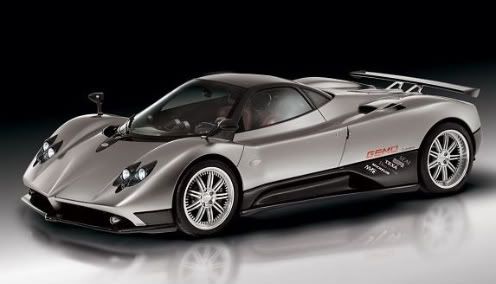
$667,321
Produced by a small independent company in Italy, the Pagani Zonda C12 F is the 5th fastest car in the world. It promises to delivery a top speed of 215 mph+ and it can reach 0-60 in 3.5 seconds.
The Zonda C12 F debuted at the 2005 Geneva Motor Show. It is the most extensive reengineering of the Pagani car yet, though it shares much with its predecessors including the 7.3 L V12. Power is increased to 602 PS (594 hp/443 kW) with a special clubsport model producing 650 PS (641 hp/478 kW). The company promises a 3.5 second sprint to 62 mph (100 km/h), a top speed over 215 mph (346 km/h). The Zonda F clubsport has a power to weight ratio of 528 bhp/ton (384 W/kg). An Enzo Ferrari, comparatively, has a power to weight ratio of 483 bhp/ton (356 W/kg).
The top speed can be further tweaked by adjusting the aerodynamic settings. 215 mph (346 km/h) is the car's top speed on the setting for the best handling which provides the most down force but also has the highest drag coefficient. If the aerodynamic settings were adjusted the top speed would be a bit higher. This also seems to be the reason that when EVO Magazine attempted the Pagani Zonda S's top speed on the Autobahn, that they were only able to get the car to 197 mph (317 km/h), as opposed to its claimed top speed of 220 mph (350 km/h). It would make sense that if the car was set up for maximum downforce then its top speed would drop to around 200 mph (320 km/h). Company representatives at Pagani's factory backed up this claim. However, the EVO article claimed that aerodynamic parts, specifically ones which created drag were in fact removed during the run, bringing Pagani's claims into question.
The Zonda F Clubsport held the record for the fastest lap by any production car around the Nürburgring, lapping the 12.9 miles (21 km) Nordschleife in 7 minutes 27.82 seconds, beating the previous record holder, the Porsche Carrera GT. It was since surpassed by the 2009 Corvette ZR1 on 7 June 2008, with a time of 7 minutes 26.4 seconds. With Marc Basseng at the wheel the Zonda F CS has set a new time around the Nürburgring, lapping the 12.9 miles (21 km) Nordschleife in 7:24.7 now only surpassed by the Maserati MC12 which set a time of 7:24.3.
Production of the Zonda F will be limited to 25 cars, still not US compatible. The next model (codenamed C9), due to be unveiled in 2009, will be fully EPA/DOT compatible.
The Zonda F, named after Formula One driver Juan Manuel Fangio, comes with an extra head light and different fog lights at the sides, new bodywork (revised front end, new rear spoiler, more aerodynamic vents all around) that improves the cars aerodynamics and different side mirrors. Further enhancements over the 'S' centre around optional carbon/ceramic brakes developed in conjunction with Brembo, magnesium wheels, inconel titanium exhaust system, hydroformed aluminum intake plenum and a redesigned 'Z preg' weave in the crash structure to improve rigidity and reduce weight.
| Production | 2005–present |
|---|---|
| Body style(s) | 2-door coupe 2-door convertible |
| Engine(s) | 7.3 L AMG V12 602 PS (443 kW/594 hp) 759 N·m (560 ft·lbf) |
| Transmission(s) | 6-speed manual |
| Wheelbase | 2728 mm (107.4 in) |
| Length | 4435 mm (174.6 in) |
| Width | 2055 mm (80.9 in) |
| Height | 1140 mm (44.9 in) |
| Curb weight | 1230 kg (2712 lb) |
6. SSC ULTIMATE AERO
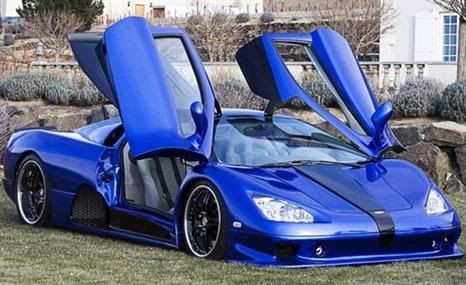
$654,400
The SSC Ultimate Aero is an American-built mid-engine supercar by Shelby SuperCars. SSC stands for Shelby SuperCars and TT stands for Twin Turbo. It's faster than its rival, the Bugatti Veyron. Its higher-performance limited production version, the SSC Ultimate Aero TT, is the second fastest production car in the world, with a recorded speed of 413 kilometres per hour (257 mph). This speed was reportedly achieved during tests on September 13, 2007 in West Richland, Washington, United States and verified by Guinness World Records on October 9, 2007.
The Aero and the Shelby SuperCars company are the brainchildren of Jerod Shelby (no relation to car designer Carroll Shelby), who spent over seven years designing the car. Although the basic Aero model is no longer produced, the Ultimate Aero is still in production with an MSRP of around $654,400.
Specifications
The new Ultimate Aero has 15% more horsepower and theoretically capable of reaching 287 mph (462 km/h), with 6th gear rated top speed of 287.102 mph (462 km/h). In order to prevent the engine from overheating, airflow to the engine has increased 20% with new carbon fiber louvers. The nose has been redesigned to make the car more aerodynamic, and the interior has been redesigned. The new Aero also has a new AeroBrake system, which is a spoiler that rises up to 8 inches when the brake is pressed to slow the vehicle.
- Length reduced to 176.2 inches (4475.5 mm)
| Manufacturer | SSC |
|---|---|
| Production | 2006–present (25 to be produced) |
| Body style(s) | 2-seat Berlinetta |
| Layout | Rear mid-engine, rear-wheel drive |
| Length | 4,475.5 millimetres (176.20 in) |
| Width | 2,095.5 millimetres (82.50 in) |
| Height | 1,092.2 millimetres (43.00 in) |
| Curb weight | 1,250 kilograms (2,800 lb) |
| Designer | Jerod Shelby |
7. SALEEN S7 TWIN TURBO
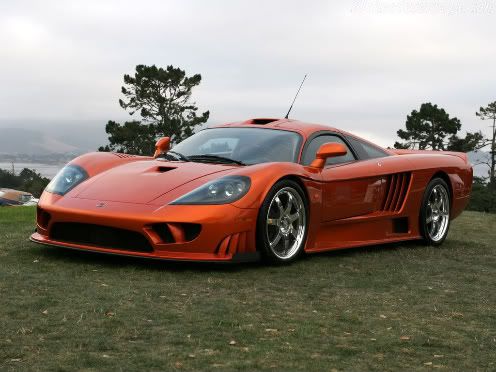
$555,000
The Saleen S7 Twin Turbo is an updated revision of the original S7. Although the initial concept for the S7 incorporated twin-turbochargers, they were not used on the production car. The twin-turbocharged version later developed in 2005 went on sale for $585,296 USD (approx. GB£295,559, c.2007/€435,203, c.2007), replacing standard S7 production.
| Manufacturer | Saleen |
|---|---|
| Production | 2005–2006[7] |
| Assembly | Irvine, California |
| Class | Super Sports car |
| Body style(s) | 2-door coupe |
| Layout | Mid-engine, rear-wheel drive[7] |
| Engine(s) | 7.0 L twin-turbocharged V8 |
| Transmission(s) | 6-speed manual[7] |
| Wheelbase | 106.3 in (2700 mm) |
| Length | 187.95 in (4774 mm) |
| Width | 78.35 in (1990 mm) |
| Height | 40.98 in (1041 mm) |
| Curb weight | 2,950 lb (1,338 kg) |
8. KOENIGSEGG CCX
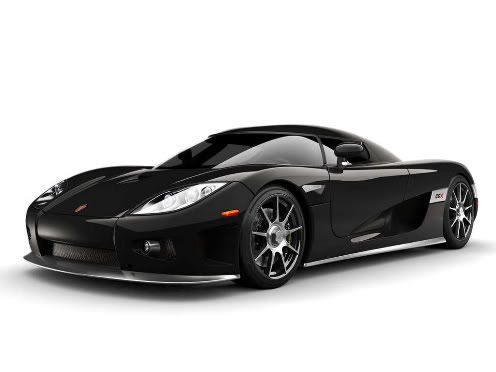
$545,568
The Koenigsegg CCX is a mid-engined roadster from Swedish car manufacturer Koenigsegg. The CCX has been engineered to comply with the U.S. regulation and market demands and is an evolutionary design that replaced the Koenigsegg CCR.
CCX is an abbreviation for Competition Coupe X; the X commemorating the 10th anniversary, (being the Roman numeral for ten), of the completion and test drive of the first CC vehicle in 1996.
The CCX was first unveiled on February 28, 2006 at the 2006 Geneva Motor Show although its existence was announced earlier. A derivative known as the CCXR is available, the main difference being that CCXR's engine is tuned to run on biofuel. The different fuel and tune allows the CCXR to produce 25% more power than the CCX.
Specifications
Engine
While previous Koenigsegg models were powered by an engined based on the Ford Modular V8 engine sourced from the U.S., and modified by Koenigsegg, the engine of the CCX was designed by Koenigsegg themselves and is built ground up in the Koenigsegg factory. The Engine block is cast for them by Grainger & Worrall, a British company that produces drivetrain components for Formula One cars. The engine is a 4.7 liter 288 cu in (4,719 cc) V8, with dual overhead camshafts and 4 valves per cylinder. The engine block is made of 356 Aluminium that has undergone a T7 heat treatment, a form of accelerated precipitation strengthening. The aluminium alloy is stronger than the previous engine and allows a thinner, thus lighter, engine block that will withstand higher cylinder pressures. The engine is boosted by two centrifugal superchargers that provide 17.5 psi (121 kPa)of boost with an 8.2:1 compression ratio. The engine produces 806 bhp (601 kW; 817 PS) at 6900rpm and 678 lb·ft (919 N·m) of torque at 5700 rpm on 91 octane (U.S. rating) gasoline. The engine is lubricated with a dry sump system with a separate oil pump, the pistons are cooled by oil sprayed onto them and the oil itself has an external cooler. The CCX engine burns 17 L/100 km (17 mpg-imp; 14 mpg-US).
| Manufacturer | Koenigsegg |
|---|---|
| Production | 2006–present |
| Predecessor | Koenigsegg CCR |
| Class | Sports car |
| Body style(s) | 2-door roadster |
| Layout | Rear mid-engine, rear-wheel drive |
| Engine(s) | 4.7 L twin-supercharged V8 |
| Transmission(s) | 6-speed manual |
| Wheelbase | 2660 mm (104.7 in) |
| Length | 4293 mm (169 in) |
| Width | 1996 mm (78.6 in) |
| Height | 1120 mm (44.1 in) |
| Curb weight | 1180 kg (2601 lb) |
| Designer | Sven-Harry Åkesson |
9. MERCEDES BENZ SLR MCLAREN ROADSTER
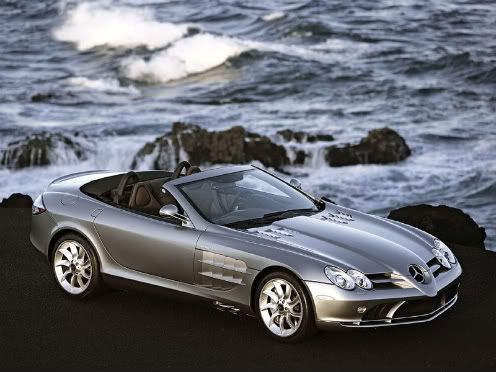
$495,000
The Mercedes-Benz SLR McLaren is an Anglo-German supercar jointly developed by Mercedes-Benz and McLaren Automotive, built in Portsmouth and the McLaren Technology Centre in Woking, Surrey, England. Daimler AG, owner of Mercedes-Benz, also owns 40% of the McLaren Group.
Due to the presence of the automatic gear box, front mid-engined arrangement and its driving characteristics lead some commentators to classify the SLR McLaren as a GT whose rivals can be considered to be vehicles like the Aston Martin DBS V12, Chevrolet Corvette ZR1, and Ferrari 599 GTB Fiorano. Mercedes decided to drop the SLR due to lack of sales in late 2007.
SLR stands for "Sport, Leicht, Rennsport" (sport, light, racing). Mercedes-Benz has stated that they will build 3500 SLRs in a span of 7 years, with an annual production of 500 cars. The car's base price is GB£300,000 (approx. US$495,000 or €346,000, c. 2009). However demand was insufficient to meet targeted sales numbers, production will end in 2009 as planned.
| |
History
The Mercedes-Benz SLR McLaren is inspired by the Mercedes-Benz 300 SLR of 1955, based on the W196 F1 car, yet named after the road-going 300SL Gullwing. On 4 April 2008, Mercedes announced they will cease production of the SLR. The last of the coupes rolled off the production line at the end of 2007 and the roadster version is due to be discontinued in early 2009.
| Manufacturer | McLaren Automotive |
|---|---|
| Parent company | Daimler AG |
| Production | 2003–2009 |
| Assembly | Woking, Surrey, England |
| Class | supercar/grand tourer |
| Body style(s) | 2-door coupé 2-door roadster |
| Layout | Front mid-engine, rear-wheel drive |
| Engine(s) | 5.4 L supercharged V8 (M115 ML55) |
| Transmission(s) | 5-speed Automatic |
| Wheelbase | 2700 mm (106.3 in) |
| Length | 4656 mm (183.3 in) |
| Width | 1908 mm (75.1 in) |
| Height | 1261 mm (49.6 in) 2006–08: 1252 mm |
10. PORSCHE CARRERA GT
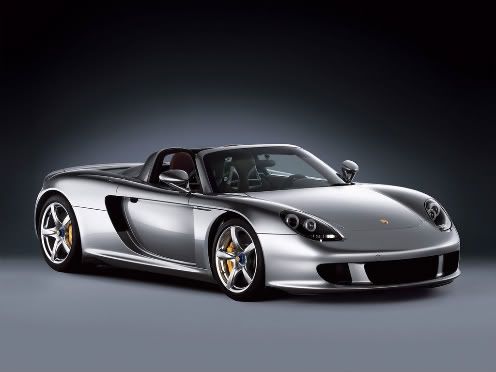
$440,000
History
The development of Carrera GT can be traced back to its predecessors, the 911 GT1 and LMP1-98 racing cars. Due in part to the FIA and ACO rule changes in 1998, both designs had ended. Porsche at the time had planned on a new Le Mans prototype for 1999. The car was initially intended to use a turbocharged flat-6, but was later redesigned to use a new V10 engine, pushing the project back to planned competition in 2000. The V10 was a unit secretly built by Porsche for the Footwork Formula One team in 1992, but later shelved. The engine was resurrected for the Le Mans prototype and increased in size to 5.7 litres. Unfortunately the project was canceled after two days of testing for the first car, in mid-1999, mostly due to Porsche's wish to build the Cayenne SUV with involvement from Volkswagen and Audi, thus requiring engineering expertise to be pulled from the motorsports division. It was also speculated that VW-Audi chairman Ferdinand Piëch wanted Audi's new Le Mans Prototype, the Audi R8 not to face competition from Porsche in 2004.
Porsche did keep part of the project alive by using the 5.5 L V10 from the prototype in a concept car shown at the 2000 Geneva Motor Show, mainly in an attempt to draw attention to their display. Surprising interest in the vehicle and an influx of revenue provided from the Cayenne helped Porsche decide to produce the car, and development started on a road-legal version that would be produced in small numbers at Porsche's new manufacturing facility in Leipzig. Porsche started a production run of Carrera GTs in 2004, shipping the units with an MSRP of $440,000 USD and a dealer invoice price of approximately $414,800 USD. In addition, the delivery charge could be as much as $5,000 USD. The first Carrera GT went on sale in the US on January 31, 2004.
Originally a production run of 1,500 cars was planned. But Porsche announced in August, 2005 that it would not continue production of the Carrera GT through 2006, citing discontinuation was due to changing airbag regulations in the US. As of May 6, 2006[update], 1,270 GT's had been manufactured, with 604 being sold in the United States.
Design
The Carrera GT is powered by a 5.7 litre V10 engine producing 612 DIN (605 SAE) horsepower (450 kW), whereas the original concept car featured a 5.5 litre version rated at 558 hp (416 kW). Porsche claims it will accelerate from 0 to 100 km/h (62.1 mph) in 3.9 seconds and has a maximum speed of 330 km/h (205 mph), although road tests indicated that in reality the car can accelerate from 0-60 mph (97 km/h) in 3.5 seconds and 0-100 mph (160 km/h) in 6.8 seconds, while 0-125 mph (201 km/h) in 9.9 seconds.
The Carrera GT has a basic five colour paint scheme which includes Guards Red, Fayence Yellow, Basalt Black, GT Silver and Seal Grey. Custom colours were also available from the factory. A traditional six-speed manual transmission is the only available transmission. Attached to this gearbox is a beechwood gearknob which pays homage to the wooden gearknob used in the Porsche 917 Le Mans racers. In its second year of production, a limited edition carbon fibre knob was also made available.
The Carrera GT has large side inlets and air dams that help cool the large V10 engine that had 612 bhp (456 kW; 620 PS) framed by the carbon fibre rear hood. Fitted with Porsche's latest Carbon fibre-reinforced Silicon Carbide (C/SiC) ceramic composite brake system, the 15-inch (380 mm) SGL Carbon disc brakes make an impressive appearance underneath the 19 inch front and 20 inch rear wheels. Similar to other Porsche models, such as the 911, the GT includes an automated rear wing spoiler which deploys above 70 mph (110 km/h).
The interior is fitted with soft leather. Bose audio system and navigation systems are available as options. In typical Porsche fashion, the ignition is to the left of the steering wheel. This placement dates back to the early days of Le Mans racing when drivers were required to make a running start, hop into their cars, start them and begin the race. The placement of the ignition enabled the driver to start the car with his left hand and put it in gear with his right.
Technology
Notable technology includes a pure carbon fiber monocoque and subframe, dry sump lubrication and inboard suspension. The carbon fiber monocoque and subframe were produced and assembled by ATR Composites Group of Italy. The spoiler of the Carrera GT extends into the air when the car reaches about 60 miles (97 km) an hour and evens out the air flow, which causes less drag. The Carrera GT radiator is about five times the size of a 911 Turbo's.
| Manufacturer | Porsche |
|---|---|
| Production | 2004–2006 (1,270 produced) |
| Assembly | Leipzig, Germany |
| Predecessor | Porsche 911 GT1 |
| Successor | Porsche GT1 |
| Class | Supercar |
| Body style(s) | 2-door roadster |
| Layout | Mid-engine, rear wheel drive |
| Engine(s) | 5.7 litre DOHC V10 |
| Transmission(s) | 6-speed manual |
| Length | 4623 mm (182 in) |
| Width | 1930 mm (76 in) |
| Height | 1168 mm (46 in) |
| Curb weight | 1380 kg (3042 lb) |
| Fuel capacity | 92 L (24.3 US gal; 20.2 imp gal) |



0 comments:
Post a Comment